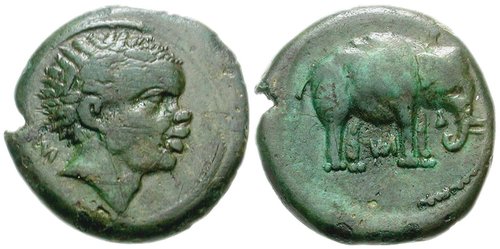Hannibal Barca was probably a black Carthaginian military commander; he became famous for his crossing of the Alps, his strategic brilliance during major campaigns, his tactical genius on the battlefield, and his intellectual prowess during combat operations. He was one of the greatest military commanders in history. During the Second Punic War, Hannibal inflicted crushing defeats on Roman armies, particularly in the battle of Cannae where 70,000 Romans died following the engagement. When his army marched toward the city of Rome, he was unable to conquer the city because his army lacked the siege equipment and reinforcement necessary to take it. In 202 BCE, the Carthagian government called Hannibal back to Africa to defend Carthage against invading Roman military forces, and there Scipio Africanus finally defeated him at the battle of Zama.
HANNIBAL BARCA’S ETHNICITY
A few historians believe that Hannibal Barca was a dark skin ethnically mixed Numidian warrior. Carthage was a mixture of indigenous black Africans, Berber tribesmen, Semitic Arabs, white Celtic Germanic warriors, Greek sojourners, and white Libyan tribesmen that existed when many Phoenician cities and colonies decorated North Africa. Although the Carthaginian government was primarily Semitic and Phoenian, Numidians dominated the Carthaginian military, which was a mixture of a black Africans, Nubians, and Berber extract that lived among the Carthaginians and who were prevalent in Egypt, Morocco, Algeria and elsewhere throughout North Africa. The Barca family originated from the celebrated Numidian warriors.
HANNIBAL BARCA COINS
European archaeologists have found eight coins portraying Hannibal’s Carthaginian features. The coins do not resemble each other. Of the eight coins, European archeologists and historians do not recognize only five coins. The five coins not recognized portray Hannibal with strong West African ethnic features. Analysis of the coins found in Italy, near the battle site of Lake Trasimene where Hannibal’s Carthaginian Army defeated the Romans, shows an African man on one side with the characteristic strong African features such as curly hair, thick lips, and full nose, on the coins opposite sideshows and elephant. All the black African looking coins have been carbon dated around the time that Hannibal was alive, but archaeologists date the Semitic looking coins roughly a century or more after Hannibal’s death.
The carbon dating of the coin is 217 BCE. Since artists depict the coin’s male image like Apollo, the Roman and Greek sun god, this indicates that he was not a common warrior riding a war elephant, but he was a high-ranking military commander. This coin is the best representation of Hannibal. The coin was found near Lake Trasimene where Hannibal defeated the Romans, this fact offers good confirmation that coin’s image resembled Hannibal’s real ethnic appearance because one of way of celebrating a victory in ancient warfare was to have a coin minted in your honor and showing yourself as your enemy’s deity. This act would have an incredibly psychological impact on the surrounding Roman population in those days.
ANALYSIS: CARTHAGINIANS AND HANNIBAL BARCA
Because Carthaginians kept no written chronicles of Hannibal’s life, historical knowledge of Hannibal originated from Carthaginian oral traditions and entirely on Roman written records. Legend suggests that before he embarked upon the Spanish campaign, Hannibal’s father (Hamilcar Barca) required the nine-year-old Hannibal to pledge his ever-lasting hatred of Rome. Carthaginians celebrated Hannibal’s crossing of the Alps with coins that depicted his face on one side and an elephant on the other. PRIMARY SOURCES: The Art of War; Andrew Roberts; 2010. The Book of War; Dwight Jon Zimmerman; 2008. The Book of Weapons; Dwight Jon Zimmerman; 2009.The Book of
